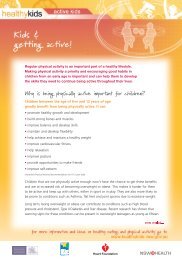I Move We Move - Good For Kids - NSW Government
I Move We Move - Good For Kids - NSW Government
I Move We Move - Good For Kids - NSW Government
You also want an ePaper? Increase the reach of your titles
YUMPU automatically turns print PDFs into web optimized ePapers that Google loves.
Stages of fundamental movement skills development<br />
Children do not naturally learn how to correctly perform fundamental movement skills as part of<br />
their normal growth and development. They need to be taught these skills and given opportunities<br />
to explore and practice them to become proficient.<br />
Although proficiency in each fundamental<br />
movement skill is not expected until<br />
the end of primary school (i.e. Year 6),<br />
the earlier these skills are introduced<br />
through play experiences and exploration,<br />
the more likely children will be to engage<br />
in physical activity throughout their lives.<br />
Children's acquisition of fundamental movement<br />
skills is characterised by a series of sequential<br />
levels as shown below in Figure 5.1.<br />
If a child doesn’t have the opportunity to go through the<br />
process of experiencing skill development in a sequential<br />
manner, proficiency in that skill is unlikely. Swimming and bicycle<br />
riding are classic examples; they are complex skills that require time, adult guidance, equipment and<br />
a suitable environment to develop and are much easier to master the earlier they are introduced 2 .<br />
See Figure 4, page P.24 in The Physical Activity Handbook – Preschoolers for<br />
detailed information on the stages of fundamental movement skills acquisition.<br />
Figure 5.1: Levels of fundamental movement skill proficiency 2<br />
Level<br />
Age<br />
group<br />
Setting<br />
Pre-control or<br />
beginner lever<br />
Most Toddlers<br />
and some<br />
Preschoolers<br />
Control or<br />
advanced<br />
beginner level<br />
Most<br />
Preschoolers<br />
Need opportunities that encourage<br />
exploration and guided discovery at<br />
Children's Service and Home<br />
I <strong>Move</strong> <strong>We</strong> <strong>Move</strong>, The Guide Edition 1 August 2009<br />
This is the<br />
level that<br />
I <strong>Move</strong> <strong>We</strong><br />
<strong>Move</strong> covers.<br />
Utilisation or<br />
intermediate<br />
level<br />
Some<br />
Preschoolers<br />
Most Primary<br />
School age<br />
children in<br />
Kindergarten<br />
to Year 4<br />
Did you know?<br />
In 2004, proficiency in the<br />
sprint run, vertical jump,<br />
overarm throw, catch and<br />
kick by <strong>NSW</strong> children in<br />
Year 6 ranged from a low<br />
of 9.7% of girls for the<br />
overarm throw to a high<br />
of 49.3% of boys for<br />
the catch 21<br />
Proficiency or<br />
advanced level<br />
Most Primary<br />
School age<br />
children in Year<br />
4 to Year 6<br />
Need opportunities that encourage<br />
exploration and guided discovery at<br />
Primary School and Home<br />
AREA HEALTH SERVICE<br />
5.2




